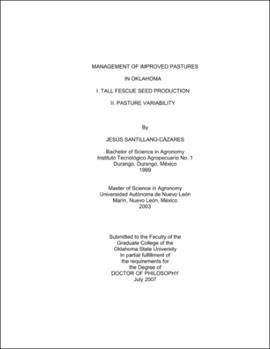Management of improved pastures in Oklahoma
I. Tall fescue seed production;
II. Pasture variability
| dc.contributor.advisor | Redfearn, Daren D. | |
| dc.contributor.author | Santillano-Cazares, Jesus | |
| dc.date.accessioned | 2013-12-10T18:04:38Z | |
| dc.date.available | 2013-12-10T18:04:38Z | |
| dc.date.issued | 2007-07 | |
| dc.identifier.uri | https://hdl.handle.net/11244/7748 | |
| dc.description.abstract | Scope and Method of Study: This study consisted of four different research projects aiming to solve specific problems in pastures management. I. The objective was to determine the feasibility of using tall fescue as a multi use crop, for seed and for forage. Four entries and two grazing treatments, fall-grazing and fall non-grazing were tested. II. This study was intended to find the main sources of variability in soil sampling of terraced pastures and to propose recommendations to help improve soil testing in terraced pastures. Fertilizers and microreliefs were fixed; years, sampling dates, and sampling sites were random. Two soil sampling methods were employed. III. The objectives were to determine the factors that define forage production and variability in terraced pastures. The same factors as described for the second experiment were used. IV. This study was intended to determine the degree of association between normalized difference vegetation index (NDVI) and forage production. Yields and NDVI readings were collected on different fertilizer treatments repeated over four pastures during five seasons. | |
| dc.description.abstract | Findings and Conclusions: I. Fall-grazing did not negatively affected seed yields or germination. It was concluded that fall-grazing is a viable component of multiple use tall fescue systems of eastern Oklahoma and north central Texas. II. Both temporal variability (associated with variation of weather) and the effect of terraces are important in affecting fertility levels. We recommend to: 1) Allow substantial precipitation to occur between grazing and sampling to minimize the effects of feces and urine spots; and 2) For a composite sample, collect soil cores representing all microrelief areas except terrace channels. Terrace channels were highly concentrated with P and K. III. Nitrogen increased yields while decreased variability, however, it depended on precipitation to achieve these results. It was concluded that currently, no real viable options can substantially reduce variability in these pastures. IV. The NDVI-forage yield relationship was unstable. It was concluded that NDVI is not an accurate index to relate with forage biomass in mixed pastures. | |
| dc.format | application/pdf | |
| dc.language | en_US | |
| dc.rights | Copyright is held by the author who has granted the Oklahoma State University Library the non-exclusive right to share this material in its institutional repository. Contact Digital Library Services at lib-dls@okstate.edu or 405-744-9161 for the permission policy on the use, reproduction or distribution of this material. | |
| dc.title | Management of improved pastures in Oklahoma | |
| dc.title | I. Tall fescue seed production | |
| dc.title | II. Pasture variability | |
| dc.contributor.committeeMember | Zhang, Hailin | |
| dc.contributor.committeeMember | Goad, Carla Lynn | |
| dc.contributor.committeeMember | Hopkins, Andrew A. | |
| dc.contributor.committeeMember | Caddel, John Levis | |
| osu.filename | Santillano-Cazares_okstate_0664D_2365 | |
| osu.accesstype | Open Access | |
| dc.type.genre | Dissertation | |
| dc.type.material | Text | |
| dc.subject.keywords | pasture management in oklahoma and texas | |
| dc.subject.keywords | tall fescue for forage and seed production | |
| dc.subject.keywords | forage variability | |
| dc.subject.keywords | terrace | |
| thesis.degree.discipline | Plant and Soil Sciences | |
| thesis.degree.grantor | Oklahoma State University |
Files in this item
This item appears in the following Collection(s)
-
OSU Dissertations [11222]
